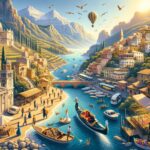Are you ready for the ultimate Italian adventure? In this article, we will guide you on how to travel Italy in 3 weeks, taking you on a journey through the enchanting regions of Northern, Central, and Southern Italy. From discovering charming cities to exploring rich history and soaking up the sun, we’ll help you plan an unforgettable trip filled with cultural immersion, delicious food, and stunning landmarks.
During the first week of your Italian adventure, we’ll show you how to discover the charm of Northern Italy. From the picturesque canals of Venice to the fashion capital of Milan, this region offers a mix of historic and modern attractions that will captivate any traveler.
In week two, we’ll take you on a journey through the rich history of central Italy, where ancient ruins and Renaissance masterpieces await. And in week three, we’ll guide you on how to soak up the sun in southern Italy, from the Amalfi Coast’s breathtaking views to the historic city of Naples.
As we guide you through each week of your trip, we’ll also highlight must-visit cities and landmarks in Italy that should be included in your itinerary. Additionally, we’ll provide insights into immersing yourself in Italian culture through its food, wine, and traditions.
Plus, we’ll share practical tips for smooth traveling in Italy and offer packing essentials to ensure a hassle-free 3-week journey through this beautiful country. So get ready to embark on the trip of a lifetime as we help you plan the ultimate 3-week Italian adventure.
Week 1
Exploring the charming and picturesque region of Northern Italy in the first week of your Italian adventure is a must. Here are some of the top destinations to add to your itinerary:
- Start your week in Milan, the fashion and design capital of Italy. Visit the iconic Duomo di Milano, explore the beautiful Galleria Vittorio Emanuele II, and take a stroll through the trendy Brera district.
- Next, make your way to Lake Como, a stunning destination known for its crystal-clear waters and breathtaking views. Take a boat tour of the lake, visit the charming town of Bellagio, and enjoy a leisurely afternoon by the water.
- Travel to Verona, famously known as the setting for Shakespeare’s Romeo and Juliet. Explore the well-preserved ancient Roman amphitheater, wander through picturesque squares, and visit Juliet’s balcony.
Northern Italy offers an array of enchanting locations that are sure to capture your heart. From vibrant cities to serene lakeside towns, this region has something for every type of traveler.
After enjoying all that Northern Italy has to offer during this first week, you’ll be ready to venture into Central Italy for another exciting leg of your journey.
- 1) Spend three days exploring Venice – Visit St. Mark’s Basilica
- 2) Explore Bologna – Visit medieval towers in Piazza Maggiore
- 3) Discover Cinque Terre – Hike along the scenic coastal trails
Week 2
After spending the first week exploring the charming cities and picturesque landscapes of Northern Italy, Week 2 offers travelers the opportunity to immerse themselves in the rich history and cultural heritage of Central Italy. From ancient ruins to Renaissance art, this region is a treasure trove for history buffs and art enthusiasts alike.
One of the must-visit cities in Central Italy is Florence, known as the birthplace of the Renaissance. Visitors can marvel at iconic landmarks such as the Duomo, Ponte Vecchio, and the Uffizi Gallery, home to works by renowned artists like Michelangelo and Botticelli. Nearby, the historic city of Siena boasts a well-preserved medieval center and hosts the famous Palio horse race twice a year.
Another highlight of central Italy is Rome, with its millennia-old history and countless ancient sites. The Colosseum, Roman Forum, and Pantheon are just a few of the awe-inspiring remnants from ancient Rome, while Vatican City offers an opportunity to see masterpieces like Michelangelo’s Sistine Chapel ceiling.
Travelers seeking a more off-the-beaten-path experience can also explore lesser-known gems like Assisi, known for its stunning Basilica of Saint Francis, or Orvieto with its striking cathedral and underground tunnels. No matter where you go in Central Italy, there’s no shortage of historical wonders to discover.
| Must-Visit Cities | Landmarks |
|---|---|
| Florence | Duomo, Ponte Vecchio, Uffizi Gallery |
| Siena | Medieval center, Palio horse race |
| Rome | Colosseum, Roman Forum, Vatican City |
Week 3
Southern Italy is a region known for its stunning coastal landscapes, rich history, and delicious cuisine. Starting the third week of your Italian adventure, you will want to take advantage of all that this area has to offer. Begin your journey in the beautiful Amalfi Coast, known for its colorful cliffside villages, crystal-clear waters, and fresh seafood. Spend a few days exploring the towns of Positano, Amalfi, and Ravello, taking in the breathtaking views of the Mediterranean Sea.
After indulging in the beauty of the Amalfi Coast, head further south to the region of Puglia. Here you will find charming towns with whitewashed buildings, ancient olive groves, and some of the most beautiful beaches in Italy. Be sure to visit Alberobello to see its unique trulli houses and explore the historic city of Lecce known as “the Florence of the South” for its stunning Baroque architecture.
To wrap up your southern Italy experience, make your way to Sicily – a region with a diverse cultural heritage influenced by Greek, Roman, Arab, Norman and Spanish civilizations. Explore Mount Etna – Europe’s highest volcano – visit ancient Greek ruins in Agrigento and enjoy flavorful Sicilian cuisine. Consider visiting Palermo’s lively markets or take time to relax on one of Sicily’s many picturesque beaches before heading back home.
Must-Visit Cities and Landmarks in Italy
When planning a 3-week trip to Italy, it can be challenging to narrow down the must-visit cities and landmarks, as the country is filled with countless iconic destinations. From historical landmarks to breathtaking natural landscapes, Italy has so much to offer for every type of traveler. Here are some of the top cities and landmarks that you should consider including in your itinerary for an unforgettable Italian adventure.
Must-Visit Cities
Italy is home to some of the most beautiful and culturally rich cities in the world. In Northern Italy, don’t miss out on exploring the romantic canals of Venice, or the fashion capital of Milan. In Central Italy, immerse yourself in the ancient history of Rome, and visit the charming hilltop towns of Tuscany. Finally, in Southern Italy, be sure to experience the vibrant streets of Naples and explore the stunning Amalfi Coast.
Landmarks Not to Miss
No trip to Italy would be complete without visiting its iconic landmarks. Marvel at the architectural wonders of the Colosseum and the Pantheon in Rome, and witness the beauty of Michelangelo’s David in Florence. Take a boat ride along the picturesque coastlines of Cinque Terre, or visit the ancient ruins of Pompeii near Naples. Of course, no visit to Italy would be complete without experiencing the grandeur of Vatican City and St. Peter’s Basilica.
Off-the-Beaten-Path Gems
In addition to these well-known cities and landmarks, consider adding some off-the-beaten-path gems to your itinerary for a more authentic Italian experience. Explore the charming fishing villages of Liguria, sample delicious seafood along with stunning coastal views. Alternatively hey may want ot discover Of enchanting small towns like Orvieto in Umbria or Matera in Basilicata – both steeped in history and culture.
No matter which cities and landmarks you choose to include in your 3-week Italian journey, remember that part of what makes travel so rewarding is venturing off course occasionally-so be open-minded along your travels through this wonderful country.
Immersing in Italian Culture
Italy is not just known for its beautiful landscapes and historical landmarks but also for its rich and diverse culture, especially when it comes to food, wine, and traditions. Immersing in Italian culture is an essential part of any trip to Italy, allowing travelers to truly experience the heart and soul of the country.
Exploring Italian Cuisine
One of the best ways to experience Italian culture is through its world-renowned cuisine. From savory pasta dishes to delectable pizzas, Italy offers a wide array of traditional dishes that vary by region. In Northern Italy, travelers can indulge in risotto and hearty stews, while Central Italy is famous for its fresh pasta and sauces.
In Southern Italy, seafood takes center stage with delicious dishes like spaghetti alle vongole (spaghetti with clams). Visitors should not miss the opportunity to dine at local trattorias and osterias to savor authentic Italian flavors.
Tasting Italian Wines
Italy’s wine culture is deeply rooted in tradition and history, making it an integral part of the country’s cultural identity. Each region boasts its own unique wine varieties, such as Chianti from Tuscany, Barolo from Piedmont, and Prosecco from Veneto.
Travelers can visit vineyards and wineries for tastings, tours, and insights into the winemaking process. Wine enthusiasts will find themselves in paradise as they explore Italy’s diverse wine regions and sample some of the finest vintages the country has to offer.
Participating in Traditional Festivities
Italy is steeped in centuries-old traditions that are celebrated through various festivals and events throughout the year. These festivities provide visitors with a glimpse into Italian customs and rituals, whether it’s the elaborate Carnivale in Venice or the historical Palio di Siena horse race. By immersing themselves in these celebrations, travelers can gain a deeper understanding of Italian culture and its significance to the local communities.
By fully embracing Italian culture through its food, wine, and traditions, visitors can enhance their overall travel experience while exploring this magnificent country over 3 weeks. Whether it’s indulging in regional cuisine, sipping on fine wines or participating in traditional festivities, immersing oneself in Italian culture is an enriching way to make the most of any trip to Italy.
Tips for Smooth Traveling in Italy
Navigating through Italy can be an incredible adventure, but it’s important to be prepared for a smooth and enjoyable trip. Here are some tips for traveling in Italy that will help you make the most of your 3-week journey through this beautiful country.
First and foremost, it’s essential to familiarize yourself with the public transportation system in Italy. The country has an extensive network of trains and buses that can take you to almost every corner of the country. Consider purchasing a rail pass if you plan on traveling between cities frequently, as this can save you both time and money.
Another tip for smooth traveling in Italy is to learn a few basic Italian phrases. While many Italians speak English, especially in popular tourist areas, knowing a few key phrases can go a long way in making connections with locals and navigating day-to-day interactions.
Additionally, be sure to familiarize yourself with local customs and etiquette. For example, when visiting churches or other religious sites, it’s important to dress modestly out of respect. It’s also common practice to greet people with a handshake or kiss on the cheek, so knowing these cultural norms can help you feel more at ease during your travels.
Lastly, be mindful of common scams and pickpocketing in popular tourist areas. Keep your belongings secure and be aware of your surroundings, especially in crowded places like markets and public transportation hubs. By staying vigilant and informed, you can ensure a safe and smooth journey as you travel Italy in 3 weeks.
Packing Essentials and Practical Advice for a 3-Week Italian Journey
When embarking on a 3-week trip to Italy, it’s crucial to pack smart and ensure that you have all the essentials for an unforgettable journey. Whether you’re exploring the northern regions, delving into the historical wonders of central Italy, or basking in the sun-drenched landscapes of the south, packing for this diverse country will require careful consideration.
First and foremost, it’s essential to pack clothing that is suitable for both urban exploration and outdoor activities. Remember to bring comfortable walking shoes, as you’ll be doing plenty of sightseeing and strolling through cobblestone streets. Additionally, consider packing layers to accommodate the varying climates across different regions of Italy. From cooler temperatures in the north to warmer weather in the south, having versatile clothing options will ensure that you are prepared for any environment.
In addition to clothing, it’s important to pack practical essentials such as an adaptable travel adapter for Italian outlets, a portable charger for your electronic devices, and a sturdy backpack or day bag for carrying your belongings while on-the-go. Furthermore, familiarize yourself with the local customs and etiquette of Italy to ensure that you are respectful during your travels.
By being mindful of these cultural nuances, you can fully immerse yourself in the rich traditions and customs of this captivating country.
Lastly, don’t forget to pack a journal or travel diary to document your experiences along the way. This will allow you to capture memories from each region of Italy and reflect on the transformative journey of how to travel Italy in 3 weeks which will surely make your adventure even more meaningful.
Conclusion
In conclusion, traveling through Italy in 3 weeks is an incredible opportunity to experience the diverse beauty and rich history of this country. From the charming cities and picturesque landscapes of Northern Italy, to the ancient ruins and cultural treasures of Central Italy, and finally to the stunning coastlines and laid-back lifestyle of Southern Italy, there is truly something for everyone in this Mediterranean gem.
By following a well-planned itinerary and taking advantage of the tips for smooth traveling in Italy, you can make the most of your three-week adventure.
One key aspect of making the most of your trip is to prioritize the must-visit cities and landmarks in each region. Whether it’s admiring the art and architecture in Florence, exploring the ancient ruins of Rome, or lounging on the beaches of Amalfi Coast, these iconic sites are not to be missed. Additionally, immersing yourself in Italian culture through its food, wine, and traditions will provide a deeper understanding and appreciation for this beautiful country.
Finally, when packing for your 3-week Italian journey, be sure to bring along essentials such as comfortable walking shoes, versatile clothing for different climates, and a universal adapter for electronics. With practical advice in mind and a sense of adventure at heart, you can truly make your trip to Italy an unforgettable experience.
No matter which part of Italy speaks to you most, from the bustling cities to serene countryside, three weeks in this enchanting country will undoubtedly leave you with memories that last a lifetime.
Frequently Asked Questions
Can You Do Italy in 3 Weeks?
Doing Italy in 3 weeks is definitely doable, but it would require careful planning and prioritizing. With so much to see and experience in the country, it’s important to map out an itinerary that allows for enough time in each destination without feeling rushed.
Is Cinque Terre or Amalfi Coast Better?
Both Cinque Terre and the Amalfi Coast offer stunning coastal views, charming villages, and delicious cuisine. Choosing between the two really depends on personal preferences. Cinque Terre is known for its colorful cliffside villages and hiking trails, while the Amalfi Coast is famous for its luxury resorts and glamorous atmosphere.
How Far in Advance Should You Plan a Trip to Italy?
It’s generally a good idea to start planning a trip to Italy at least 6-12 months in advance, especially if you’re traveling during peak tourist season or want to secure accommodations in popular areas like Rome, Florence, or Venice. This allows for ample time to research and book flights, hotels, tours, and transportation arrangements.
However, spontaneous trips can also be enjoyable if you’re flexible with your travel plans.

I’m a passionate traveler, writer, and Italophile. My fascination with Italy’s history, art, and culture has led me on countless adventures across the Italian landscape. Through “I Live Italy,” I share my love for this extraordinary country and aims to inspire others to explore its boundless beauty.





